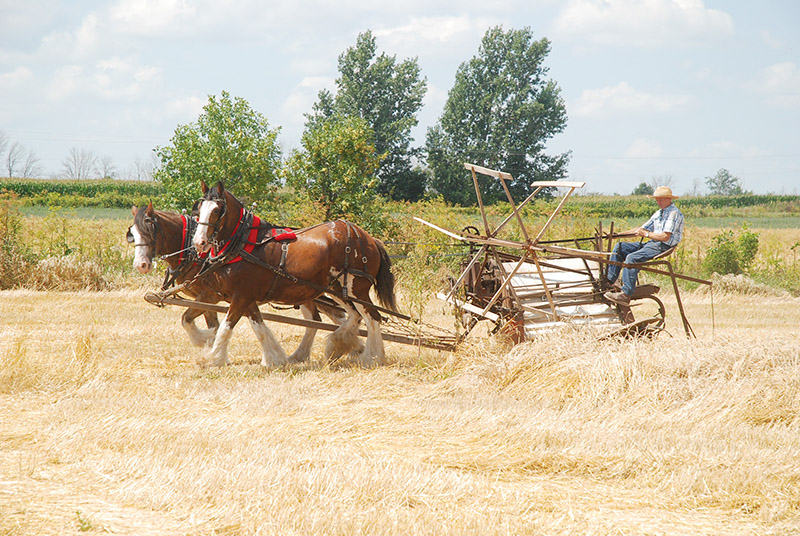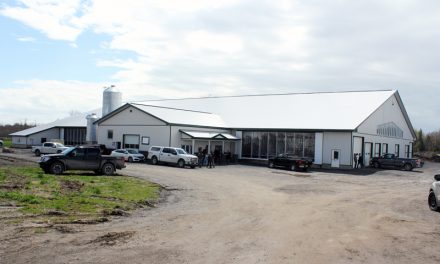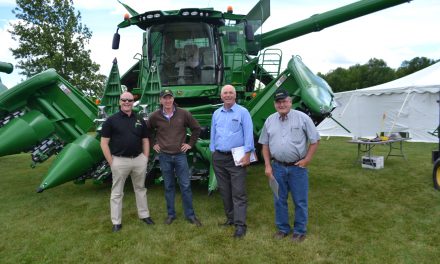Brain McIntosh takes his team down one side of the field using a binder. Morin Photo
The Leeds County Draft Horse Club, (LCDHC), held one of its annual outings at Brian McIntosh’s Bri-McFarm, farm on Sat., Aug 6, in Inkerman.
There were four teams of draft horses working at the event, as well as a large group of members from the club.
The Leeds County Draft Horse Club was created in 1986 with an initial 12 members. In the intervening years, the club has grown to more than 70 families.
A statement on the club’s webpage states: “We welcome a diversity of horse-related interests, from photography and art, through harness making or carriage building, to antique horse-drawn equipment.
Purpose
The LCDHC is a not-for-profit organization with a goal to help preserve the significance of the draft horse, through promoting proper care and use for agriculture and or recreation.”
Despite the hot weather at the Inkerman event, members and their teams had fun and were able to experience what it would have been like to harvest and thresh a field before the advent of the tractor and modern day harvesting and threshing equipment.
Club president Brian McIntosh said, “We had four teams and then there was my filly because she was still with her mother, so we tied her to the side of her mother.”
This year the group harvested wheat with the binder. They used tractor provided power for the threshing mill.
The day is devoted to taking a walk back in time.
“My idea when I started it four years ago was education, entertainment and then there is the whole other social aspect of it too,” said McIntosh.
“Most of the people who came are older and they remember it and they come and talk to people who are the same age and shared that experience. We always have some young people as well and we try to encourage participation so that they get a little bit more to take home with them.”
A bystander watching a group of farmers harvest a crop and doing it without modern equipment might think what they are watching is more work than play but club members do not feel that way.
Mcintosh said, “It’s so much fun that we do not look at it as work because we do not do it all day. These men who are 80 years old now, used to do it all day long for a few weeks at a time. That was work.”
During the day, different people will step out onto the field to take part for a little while in one aspect of the harvesting process or another, then return to a tented area for something to eat and a chance to chat with fellow members.
“We encourage the spectators to go out to the field along with the wagon and horses and help. Some people like to throw into the threshing mill too. That’s an experience for them. The straw comes out the one end and the grain comes out the other side of the mill because it has all been separated inside the machine and some people have no idea how that happens. That is the education part of it,” said McIntosh.
Some of the spectators also enjoy just watching the horses work.
“We had three different breeds there this year, which was really nice. We shared the work amongst the horses. We did not over work them.
This year, McIntosh found a four-horse sweep. This devise would have been used before the use of the modern-day tractor.
“The sweep produces power and comes out as a rotating shaft underneath and it runs to a belt running another threshing machine.”
Mcintosh has a threshing machine that was built prior to 1900. It is smaller than the one that was connected to a tractor for the day and could easily be powered by the sweep.
You can see the sweep in action at the club’s website and Facebook page. Just search for Leeds County Draft Horse Club page.
The club has informative and interesting presentations at their meetings about horse health and care, breed profiles. Members of the club include several draft breeds in their interests such as Belgians, Clydesdales, and Percherons. Heritage breeds such as Canadians, Shires, and Suffolk Punches; or the more recent arrivals to North America like the Fjords and Haflingers.
An excerpt from the club’s webpage states: “The draft horse is a large, powerful animal that played a major part in the civilization of man. Before 1910, at least 90 per cent of all agriculture and resource industries relied on ‘horsepower’ to complete jobs both large and small. After the World War II and the climb of mechanization, the need for these ‘gentle giants’ diminished greatly.”












